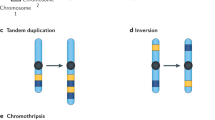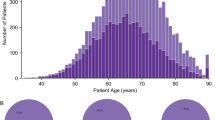Abstract
Although recurrent gene fusions involving erythroblastosis virus E26 transformation-specific (ETS) family transcription factors are common in prostate cancer, their products are considered 'undruggable' by conventional approaches. Recently, rare targetable gene fusions involving the anaplastic lymphoma receptor tyrosine kinase (ALK) gene, have been identified in 1–5% of lung cancers1, suggesting that similar rare gene fusions may occur in other common epithelial cancers, including prostate cancer. Here we used paired-end transcriptome sequencing to screen ETS rearrangement–negative prostate cancers for targetable gene fusions and identified the SLC45A3-BRAF (solute carrier family 45, member 3–v-raf murine sarcoma viral oncogene homolog B1) and ESRP1-RAF1 (epithelial splicing regulatory protein-1–v-raf-1 murine leukemia viral oncogene homolog-1) gene fusions. Expression of SLC45A3-BRAF or ESRP1-RAF1 in prostate cells induced a neoplastic phenotype that was sensitive to RAF and mitogen-activated protein kinase kinase (MAP2K1) inhibitors. Screening a large cohort of patients, we found that, although rare, recurrent rearrangements in the RAF pathway tend to occur in advanced prostate cancers, gastric cancers and melanoma. Taken together, our results emphasize the key role of RAF family gene rearrangements in cancer, suggest that RAF and MEK inhibitors may be useful in a subset of gene fusion–harboring solid tumors and demonstrate that sequencing of tumor transcriptomes and genomes may lead to the identification of rare targetable fusions across cancer types.
This is a preview of subscription content, access via your institution
Access options
Subscribe to this journal
Receive 12 print issues and online access
$209.00 per year
only $17.42 per issue
Buy this article
- Purchase on Springer Link
- Instant access to full article PDF
Prices may be subject to local taxes which are calculated during checkout




Similar content being viewed by others
References
Soda, M. et al. Identification of the transforming EML4-ALK fusion gene in non–small-cell lung cancer. Nature 448, 561–566 (2007).
Tomlins, S.A. et al. Recurrent fusion of TMPRSS2 and ETS transcription factor genes in prostate cancer. Science 310, 644–648 (2005).
Kumar-Sinha, C., Tomlins, S.A. & Chinnaiyan, A.M. Recurrent gene fusions in prostate cancer. Nat. Rev. Cancer 8, 497–511 (2008).
Koivunen, J.P. et al. EML4-ALK fusion gene and efficacy of an ALK kinase inhibitor in lung cancer. Clin. Cancer Res. 14, 4275–4283 (2008).
Maher, C.A. et al. Chimeric transcript discovery by paired-end transcriptome sequencing. Proc. Natl. Acad. Sci. USA 106, 12353–12358 (2009).
Wang, X.-S. et al. Integrative analyses reveal functional and genetic associations of gene fusions in cancer. Nat. Biotechnol. 27, 1005–1011 (2009).
Cohen, Y. et al. BRAF mutation in papillary thyroid carcinoma. J. Natl. Cancer Inst. 95, 625–627 (2003).
Davies, H. et al. Mutations of the BRAF gene in human cancer. Nature 417, 949–954 (2002).
Wang, L. et al. BRAF mutations in colon cancer are not likely attributable to defective DNA mismatch repair. Cancer Res. 63, 5209–5212 (2003).
Xing, M. BRAF mutation in thyroid cancer. Endocr. Relat. Cancer 12, 245–262 (2005).
Ciampi, R. et al. Oncogenic AKAP9-BRAF fusion is a novel mechanism of MAPK pathway activation in thyroid cancer. J. Clin. Invest. 115, 94–101 (2005).
Jones, D.T. et al. Tandem duplication producing a novel oncogenic BRAF fusion gene defines the majority of pilocytic astrocytomas. Cancer Res. 68, 8673–8677 (2008).
Dessars, B. et al. Chromosomal translocations as a mechanism of BRAF activation in two cases of large congenital melanocytic nevi. J. Invest. Dermatol. 127, 1468–1470 (2007).
Wilhelm, S.M. et al. Preclinical overview of sorafenib, a multikinase inhibitor that targets both Raf and VEGF and PDGF receptor tyrosine kinase signaling. Mol. Cancer Ther. 7, 3129–3140 (2008).
Sala, E. et al. BRAF silencing by short hairpin RNA or chemical blockade by PLX4032 leads to different responses in melanoma and thyroid carcinoma cells. Mol. Cancer Res. 6, 751–759 (2008).
Esgueva, R. et al. Prevalence of TMPRSS2-ERG and SLC45A3-ERG gene fusions in a large prostatectomy cohort. Mod. Pathol. 23, 539–546 (2010).
Han, B. et al. A fluorescence in situ hybridization screen for E26 transformation-specific aberrations: identification of DDX5–ETV4 fusion protein in prostate cancer. Cancer Res. 68, 7629–7637 (2008).
Tomlins, S.A. et al. Distinct classes of chromosomal rearrangements create oncogenic ETS gene fusions in prostate cancer. Nature 448, 595–599 (2007).
Helgeson, B.E. et al. Characterization of TMPRSS2:ETV5 and SLC45A3:ETV5 gene fusions in prostate cancer. Cancer Res. 68, 73–80 (2008).
Maher, C.A. et al. Transcriptome sequencing to detect gene fusions in cancer. Nature 458, 97–101 (2009).
Rickman, D.S. et al. SLC45A3–ELK4 is a novel and frequent erythroblast transformation-specific fusion transcript in prostate cancer. Cancer Res. 69, 2734–2738 (2009).
Warzecha, C.C., Sato, T.K., Nabet, B., Hogenesch, J.B. & Carstens, R.P. ESRP1 and ESRP2 are epithelial cell-type-specific regulators of FGFR2 splicing. Mol. Cell 33, 591–601 (2009).
Cho, N.Y. et al. BRAF and KRAS mutations in prostatic adenocarcinoma. Int. J. Cancer 119, 1858–1862 (2006).
MacConaill, L.E. et al. Profiling critical cancer gene mutations in clinical tumor samples. PLoS One 4, e7887 (2009).
Garte, S.J., Currie, D.D. & Troll, W. Inhibition of H-ras oncogene transformation of NIH3T3 cells by protease inhibitors. Cancer Res. 47, 3159–3162 (1987).
Hoeflich, K.P. et al. In vivo antitumor activity of MEK and phosphatidylinositol 3-kinase inhibitors in basal-like breast cancer models. Clin. Cancer Res. 15, 4649–4664 (2009).
Pratilas, C.A. et al. (V600E)BRAF is associated with disabled feedback inhibition of RAF-MEK signaling and elevated transcriptional output of the pathway. Proc. Natl. Acad. Sci. USA 106, 4519–4524 (2009).
Jeong, J.H. et al. BRAF activation initiates but does not maintain invasive prostate adenocarcinoma. PLoS One 3, e3949 (2008).
Janknecht, R. Analysis of the ERK-stimulated ETS transcription factor ER81. Mol. Cell. Biol. 16, 1550–1556 (1996).
Bosc, D.G. & Janknecht, R. Regulation of Her2/neu promoter activity by the ETS transcription factor, ER81. J. Cell. Biochem. 86, 174–183 (2002).
Kleer, C.G. et al. EZH2 is a marker of aggressive breast cancer and promotes neoplastic transformation of breast epithelial cells. Proc. Natl. Acad. Sci. USA 100, 11606–11611 (2003).
Cao, Q. et al. Repression of E-cadherin by the polycomb group protein EZH2 in cancer. Oncogene 27, 7274–7284 (2008).
Acknowledgements
We thank R.B. Jenkins (Mayo Clinic) for providing prostate cancer tissues with BRAF overexpression for FISH evaluation, R. Morey for assistance in paired-end sequencing and Illumina for technical support. We thank T. Barrette, R. Lonigro, M. Quist, C. Quist and S. Begley for hardware support, sample database maintenance, data curation and maintenance of paired-end sequence data and useful discussions; D. Sanders and M.Vinco for their assistance in procuring gastric cancer samples; and D. Kim, R. Mehra and R. Varambally for providing prostate and melanoma tissue microarray and clinical information from the University of Michigan cohort. We thank D.F. Fries, X. Jiang, L. Wang, R. Jagirdar, N. Kitabayashi and X. Jing for technical assistance, K. Giles for critical reading of the manuscript and A.K. Tewari, Biobank, Weill Cornell Medical College, for providing prostate cancer samples for mutation analysis. This work was supported in part by the US National Institutes of Health (R01CA132874), Early Detection Research Network grant UO1 CA111275, Prostate SPORE grant P50CA69568, the National Center for Integrative Bioinformatics (U54 DA21519-01A1), the National Center for Functional Genomics supported by the Department of Defense (A.M.C.) and R01 CA125612-01 (M.A.R. and F.D.). S.A.T. is supported by a Young Investigator Award from the Prostate Cancer Foundation. A.M.C. is supported by the Doris Duke Charitable Foundation Clinical Scientist Award, a Burroughs Welcome Foundation Award in Clinical Translational Research and the Prostate Cancer Foundation. A.M.C. is an American Cancer Society Research Professor. N.P. is supported by the development award from the Melanoma Research Alliance. C.A.M. currently derives support from the American Association of Cancer Research Amgen Fellowship in Clinical/Translational Research, the Canary Foundation and American Cancer Society Early Detection Postdoctoral Fellowship, and a Prostate Cancer Foundation Young Investigator Award. B.A. is supported by a Genentech Foundation Postdoctoral Fellowship and Young Investigator Award from Expedition Inspiration. T.A.B. is supported by funding from the Prostate Cancer Foundation, a Young Investigator Award and the Canadian Institute of Health Research.
Author information
Authors and Affiliations
Contributions
N.P., B.A., S.A.T., C.A.M. and A.M.C. designed experiments and wrote the manuscript. N.P. performed paired-end transcriptome library preparation and FISH probe design, preparation and analysis. S.K.-S. and C.A.M. performed bioinformatics analysis for gene fusion nominations. B.A., K.R., S.S., Q.C., S.M.D., S.V. and S.A.T. conducted experiments including design and generation of expression constructs, in vitro assays, western blotting, qRT PCR validation and data analysis and interpretation. B.A. performed in vivo experiments. N.P., B.H., K.S. and D.P. performed FISH assays on cancer tissue microarrays. X.C. performed sequencing. C.K.-S. performed BRAF mutation analysis by pyrosequencing. Y.-b.C., R.E., S.B., C.J.L., J.S., F.D., P.M., T.A.B., R.K. and M.A.R. provided prostate cancer specimens and performed FISH assays. D.R.F. and T.M.J. provided melanoma tissue microarrays. T.J.G. and J.K.G. provided gastric cancer tissue microarrays. P.T. provided gastric cancer tissues and RNAs. A.M.C. directed the study.
Corresponding author
Ethics declarations
Competing interests
The authors declare no competing financial interests.
Supplementary information
Supplementary Text and Figures
Supplementary Figures 1–7, Supplementary Table 1 and Supplementary Methods (PDF 854 kb)
Rights and permissions
About this article
Cite this article
Palanisamy, N., Ateeq, B., Kalyana-Sundaram, S. et al. Rearrangements of the RAF kinase pathway in prostate cancer, gastric cancer and melanoma. Nat Med 16, 793–798 (2010). https://doi.org/10.1038/nm.2166
Received:
Accepted:
Published:
Issue Date:
DOI: https://doi.org/10.1038/nm.2166
This article is cited by
-
The role of CRAF in cancer progression: from molecular mechanisms to precision therapies
Nature Reviews Cancer (2024)
-
MTAP-ANRIL gene fusion promotes melanoma epithelial-mesenchymal transition-like process by activating the JNK and p38 signaling pathways
Scientific Reports (2023)
-
AK2 is an AMP-sensing negative regulator of BRAF in tumorigenesis
Cell Death & Disease (2022)
-
Identification of fusions with potential clinical significance in melanoma
Modern Pathology (2022)
-
Investigation on the cellular mechanism of Prunetin evidenced through next generation sequencing and bioinformatic approaches against gastric cancer
Scientific Reports (2022)



